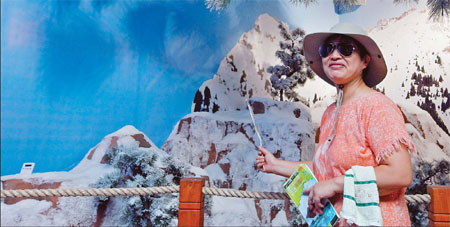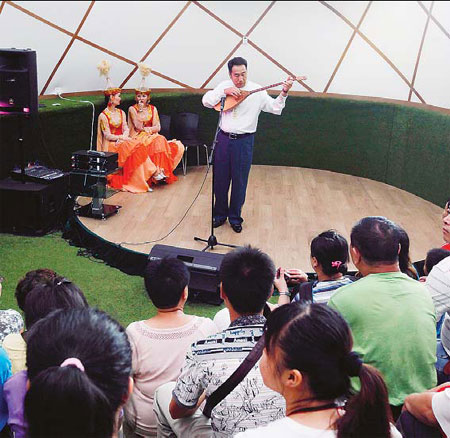A very cool welcome
 |
| The Kazakhstan Pavilion creates a frozen world to show visitors what it is like to live in Astana, the second-coldest capital city in the world. |
 |
| Traditional music and dance performances are held daily in the pavilion. |
The Kazakhstan Pavilion demonstrates what it is like to live in one of the world's coldest cities, Tang Zhihao reports.
A chilled room in the Kazakhstan Pavilion, replete with artificial snow, gives visitors an idea what it is like to live in the second-coldest capital city in the world - Astana.
The capital of this Central Asian country is in the deep freeze for up to six months every year, with temperatures of -35 C to -40 C common in the early winter. The coldest capital city in the world is Ulan Bator in Mongolia.
To enter the chilled world that depicts winter in Kazakhstan, visitors need to cross a bridge covered in snow. Stand on the bridge and a winter wonderland appears with snow-covered pine trees and even a jolly snowman.
"We want to show visitors what life in winter is like in our capital city," said Raikhan Dilmagambetova, the director of the Kazakhstan Pavilion.
"The Asian Winter Games will be held in Astana in 2011, so it is a good chance for visitors to experience our winter in advance."
Themed "Astana - the Heart of Eurasia", the pavilion occupies an area of 1,000 square meters and was designed to show how people in Astana cope with its long, cold winters.
A 12-meter-high replica of the city's symbolic landmark, Bayterek Tower, has a prominent place in the pavilion.
At 97 meters, Bayterek Tower is a favorite place for local residents to get a bird's eye view of the city. The tower's height symbolizes the date Astana became the capital of Kazakhstan - 1997. The previous capital city was Almaty.
With brown ribbons decorating the pavilion's faade, designers intended to imitate the traditional tent-like dwelling in Kazakhstan, the yurta.
"Ribbons are normally used to decorate yurtas in Kazakhstan," said Dilmagambetova. He said yurtas can still be found in rural areas but are rarely in large cities.
"We want to give visitors a sense of what yurtas look like in our country," he said.
This is the first time that Kazakhstan has had its own pavilion at a World Expo. The pavilion hosts 3,000 visitors a day. It takes about 20 minutes to tour around the pavilion.
In the pavilion, an audiovisual display informs visitors of the history of Astana and its current development.
To help Chinese visitors understand the exhibits, 48 young bilingual Kazakhs, who are taking undergraduate or postgraduate studies in Shanghai, are at the ready to assist visitors. The students have been divided into three groups and guide visitors' throughout the pavilion.
The students are also trained to interact with visitors when they walk into the pavilion and give them directions on how to use to pavilion's interactive displays.
Staff in the pavilion wear a uniform of yellow shirts and trousers and a blue jacket.
"It is the color of our national flag," said Daniyar, a student at the Shanghai University of Finance and Economics.
To make visitors better understand the culture in Kazakhstan, traditional performances are held daily in the pavilion. Many famous Kazakh artists perform to offer visitors a better understanding of the country.
Due to the pavilion's limited capacity - only 50 visitors can enter at one time - it can take up to three hours to get inside. Pavilion officials say the queues are a lot shorter in the evening and recommend visits at that time.
 0
0 






